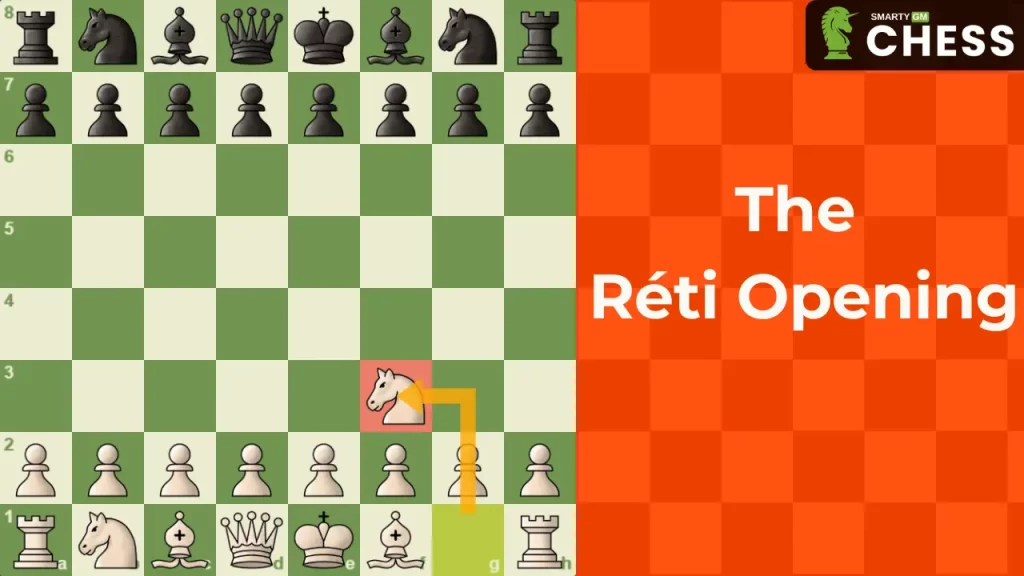Most white openings start with the move e4 or d4, but today, with the Réti opening, there is something different as it begins with Nf3.
In this article, we delve into the intricacies of the Réti opening, exploring its history, variations, key concepts, Traps, and enduring impact on modern chess strategy.
Read also: How to Play King’s Fianchetto Opening
What is The Réti Opening?
The Réti is an opening that start with 1. Nf3, named after the Czech grandmaster Richard Réti.
This opening defies traditional principles by delaying the central pawn moves. Instead, it focuses on flexible piece development and control of the board’s center from a distance.
Black usually responds with d5 to take the center, and we will cover how to play against them.
How you can set up The Réti Opening?
To set up the Réti Opening, you start by playing 1.Nf3. Your opponent usually responds with d5.
Next, You may fianchetto your kingside bishop with g3 and Bg2, controlling key diagonals, or play c4 to destroy the center.
The Réti Variations
When you play Nf3 first, your opponent responds with d5, so, you need to play c3, and you get three variations:
Reti Gambit Accepted, Reti Gambit Advance Variation, Reti Gambit Declined.
Reti Gambit Accepted
If Black accepts the gambit and takes your c4 pawn, then you play immediately e3 targeting the Pawn and gain a very active game with some nice development:
Here, if Black tries to hang on to the d5-pawn with a move like Be6, we could play a move like knight to a3, and Black can’t defend the c4 Pawn anymore.
Then, you will take with the Knight or the Bishop, depending on which piece you would rather have standing at the end of this exchange.
If Black plays Queen to d5 trying to defend the pawn we can kick it away by the move Nc3:
If Black defends the c4 Pawn with a move like d5, we play a4. So, if he plays bxa4, he will get two double Pawn sets, and we can take them whenever we want.
And if he doesn’t take and play b4, we take the c4 Pawn with our Bishop.
Finally, if he doesn’t take on a4 and defend with a5, we take, and if he takes back, we get a free Rook on a8.
Reti Gambit Advance Variation
The advanced variation happens when Black pushes his d5 pawn down to d4, deciding not to capture on c4.
Here, I’m recommending you play g3 followed by bishop g2 fianchettoing our light-squared bishop, and after your opponent plays move like e5, play d3.
Notice what we’re doing here with our pawns on these light squares. We’re eyeing the key light squares in the center of the board, not to mention our bishop on g2 pouncing down all the way to c6.
After that, we’re going to castle and continue the middle game with a very good position.
Reti Gambit Declined
In case your opponent plays c6 or e6 defending the Pawn, we can play many good moves, such as b3:
So, if he takes, we take back with our b3-Pawn getting rid of their central Pawn.
If they don’t take and play another move like Nf6, we play Bb2, controlling the diagonal line.
Then, we can develop our pieces and castle:
Advantages and weaknesses of The Réti Opening
There are many advantages and disadvantages to The Réti Opening, including:
Advantages
- Need less memorization of opening theory
- Flexibility
- Surprise Value
Disadvantages
- Potential for Passive Positions
Read also: Learn The Caro-Kann Defense
The Réti Opening Traps
Now, we show you some traps in the reti opening, you can use it against your oponnent:
Trap 1 – Queen Sacrifice
Trap 2 – Take a Free Queen
Famous games played using The Réti Opening
There are many players using The Réti Opening including Reti himself and other players like Hikaru, Fabiano and more.
Hikaru Nakamura (2794) Vs. Fabiano Caruana (2805)
Richard Reti (2710) Vs. Akiba Rubinstein (2640)
Resources
Frequently asking questions (FAQ)
Yes, the Réti Opening is a good choice for players who enjoy flexible and strategic play. It offers a wide range of setups and can lead to dynamic and unbalanced positions, challenging opponents of all levels.
To respond to the Réti Opening, players can aim for solid development with moves like d5 or e6, challenging White’s control of the center. Alternatively, fianchettoing the king’s bishop or transposing into other openings are viable options.


